The Water Flow Regime in the Weir Area for Vascular and Rush Plant Species Composition
Abstract
:1. Introduction
2. Materials and Methods
Study Area
- -
- The inhibition of the progressive bed erosion;
- -
- Prevent groundwater raising in the adjacent area;
- -
- Promote agricultural land irrigation on an area of about 150 ha;
- -
- For recreational purposes.
3. Results and Discussion
3.1. Granulometric Properties
3.2. Total Species Number
3.3. Water and Rush Species
3.4. Submerged and Emerged Species
3.5. Characteristic Species
4. Conclusions
- Diverse habitats can be created for different plant species by designing and constructing a variety of hydraulic structures that create conditions with varying degrees of shading. This increases the biodiversity of the aquatic ecosystem.
- The competent design of hydrotechnical structures can help create ecological corridors that allow plants and animals to migrate between various river zones. This can contribute to gene exchange and maintain healthy populations.
- Weirs can reduce the fluctuations in river water levels. Then, stable water levels can create favorable conditions for vegetation, thereby reducing extreme environmental changes that could affect species that are sensitive to water fluctuations (swordfish, European catfish, pike, etc.).
- The use of hydraulic structures to regenerate natural wetlands can help restore habitats for specialized plant species that have adapted to such conditions.
- Hydraulic structures can be used to control invasive plant species by introducing physical barriers or by carrying out remedial measures to maintain a healthy species composition.
- The systematic monitoring of vegetation along river courses and the impact of hydrotechnical structures analyses can provide valuable information on the effectiveness of measures and the needed adjustments to improve the health and diversity of aquatic ecosystems.
- The hydrotechnical development of the riverbed leads to the stabilization of conditions above the water surface; however, in the lower position of the structure, unfavorable conditions may be created for some plant species, which poorly tolerate periodically low water surface levels or are not suitable for the constant availability of a certain water level. The construction of weirs may lead to a change in the natural water flow conditions, which may affect the availability of water for the vegetation on the banks and bottom of the river.
- Weir construction may lead to changes in breeding habitats for aquatic vegetation. Nesting plants, such as species associated with submerged areas, may have difficulty reproducing, as these structures may disrupt their natural reproductive cycles.
- Fluctuations in the water levels caused by weir operations can contribute to increased erosion of the river banks. This can lead to the loss of bank vegetation habitats and changes in the river ecosystem.
- Vegetation on the riverbed and banks can be sensitive to changes in access to light. The construction of weirs may affect the shading of some areas, which may have a negative impact on plant species that require intense sunlight for photosynthesis.
- -
- First and foremost, prior to commencing the construction project, a thorough understanding of the river ecosystem where the vegetation structure will be established is of utmost importance. Conducting scientific research and consulting with experts can aid in selecting suitable plant species and determining the most appropriate areas for development.
- -
- Preferring native plant species that naturally occur in the region is advisable. This approach reduces the risk of disrupting the existing ecosystem and contributes to the preservation of biodiversity.
- -
- Planning of the vegetation structure should aim to create diverse habitats. Such planning must take into account the location of the structure (whether it is situated on the upper or lower part of the weir), which is characterized by varying water depths, shallow coastal zones, landforms, and areas with natural bends, in order to promote a diversity of vegetation and provide favorable conditions for different species.
- -
- In the lower section of the weir, where there is an increased vulnerability to erosion, it is crucial to select plant species that are well adapted to retaining soil and stabilizing the ground.
- -
- Following the completion of the construction project, consistent and vigilant monitoring of the vegetation’s condition and its effects on the ecological landscape is imperative.
Author Contributions
Funding
Institutional Review Board Statement
Informed Consent Statement
Data Availability Statement
Conflicts of Interest
References
- Wollny, J.T.; Otte, A.; Harvolk-Schöning, S. Riparian plant species composition alternates between species from standing and flowing water bodies—Results of field studies upstream and downstream of weirs along the German rivers Lahn and Fulda. Ecol. Eng. 2019, 139, 105576. [Google Scholar] [CrossRef]
- Wollny, J.T.; Bergmann, W.; Otte, A.; Harvolk-Schöning, S. River regulation intensity matters: Riverbank vegetation is characterized by more typical riverbank plant species with increasing distance from weirs. Ecol. Eng. 2021, 159, 106082. [Google Scholar] [CrossRef]
- Mueller, M.; Pander, J.; Geist, J. The effects of weirs on structural stream habitat and biological communities. J. Appl. Ecol. 2011, 48, 1450–1461. [Google Scholar] [CrossRef]
- Almeida, E.F.; Oliveira, R.B.; Mugnai, R.; Nessimian, J.L.; Baptista, D.F. Effects of Small Dams on the Benthic Community of Streams in an Atlantic Forest Area of Southeastern Brazil. Int. Rev. Hydrobiol. 2009, 94, 179–193. [Google Scholar] [CrossRef]
- Brooks, A.J.; Wolfenden, B.; Downes, B.J.; Lancaster, J. Barriers to dispersal: The effect of a weir on stream insect drift. River Res. Appl. 2018, 34, 1244–1253. [Google Scholar] [CrossRef]
- Włodarczyk, A. The impact of Konstancin-Jeziorna weir on the quality and quantity of water resources and phytocenosis of Jeziorka River. Sci. Rev. Eng. Environ. Sci. 2006, 2, 121–129. [Google Scholar]
- Anggraheni, D.; Makrup, L.; Pratiwi, W.; Virgiawan, A. Hydraulic jump generation by weir model and leap length study for practice purpose. Int. J. Civ. Eng. Technol. 2017, 8, 1107–1119. [Google Scholar]
- Mossa, M.; Meftah, M.B.; De Serio, F.; Nepf, H.M. How vegetation in flows modifies the turbulent mixing and spreading of jets. Sci. Rep. 2017, 7, 6587. [Google Scholar] [CrossRef] [PubMed]
- Majewski, W. Hydraulic Model Tests in Water Engineering; Institute of Meteorology and Water Management, National Research Institute: Warsaw, Poland, 2019. (In Polish) [Google Scholar]
- Knight, D.W.; Shiono, K. River channel and floodplain hydraulics, floodplain processes. In Floodplain Processes; Anderson, M.G., Walling, D.E., Bates, P.D., Eds.; John Wiley and Sons Ltd.: Hoboken, NJ, USA, 1996. [Google Scholar]
- Västilä, K. Flow–Plant–Sediment Interactions: Vegetative Resistance Modeling and Cohesive Sediment Processes. Ph.D. Thesis, Aalto University, Aalto, Finland, 2015. [Google Scholar]
- Ennos, A.R. The aerodynamics and hydrodynamics of plants. J. Exp. Biol. 1999, 202, 3281–3284. [Google Scholar] [CrossRef]
- Wetzel, R.G. Land–water interfaces: Larger plants. Limnology 2001, 18, 527–575. [Google Scholar] [CrossRef]
- Tang, H.; Yuan, S.; Cao, H. Theory and Practice of Hydrodynamic Reconstruction in Plain River Networks. Engineering 2022, in press. [Google Scholar] [CrossRef]
- Ciullo, A.; Bruijn, K.M.; Kwakkel, J.H.; Klijn, F. Accounting for the uncertain effects of hydraulic interactions in optimising embankments heights: Proof of principle for the IJssel River. J. Flood Risk Manag. 2019, 12, e12532. [Google Scholar] [CrossRef]
- Thai, T.H.; Tri, D.Q. Combination of hydrologic and hydraulic modeling on flood and inundation warning: Case study at Tra Khuc-Ve River basin in Vietnam. Vietnam J. Earth Sci. 2019, 41, 240–251. [Google Scholar] [CrossRef]
- Calabresi, G.; Colleselli, F.; Danese, D.; Giani, G.; Mancuso, C.; Montrasio, L.; Nocilla, A.; Pagano, L.; Reali, E.; Sciotti, A. Research study of the hydraulic behaviour of the Po River embankments. Can. Geotech. J. 2013, 50, 947–960. [Google Scholar] [CrossRef]
- Dawson, F.H. Water Flow and the Vegetation of Running Waters. In Vegetation of Inland Waters; Springer Netherlands: Dordrecht, The Netherlands, 1988; pp. 283–309. [Google Scholar]
- Tang, C.; Yi, Y.; Jia, W.; Zhang, S. Velocity and turbulence evolution in a flexible vegetation canopy in open channel flows. J. Clean. Prod. 2020, 270, 122543. [Google Scholar] [CrossRef]
- Matuszkiewcz, W. Guide to the Determination of Plant Communities in Poland; Polish Scientific Publishing House PWN: Warsaw, Poland, 2012. (In Polish) [Google Scholar]
- Halabowski, D.; Lewin, I. Impact of anthropogenic transformations on the vegetation of selected abiotic types of rivers in two ecoregions (Southern Poland). Knowl. Manag. Aquat. Ecosyst. 2020, 421, 35. [Google Scholar] [CrossRef]
- BN-62/6738-05; Hydrotechnical Concrete—Concrete Tests. Polish Committee for Standardization: Warsaw, Poland, 2005.
- EN 1992-1-1:2008; Eurocode 2: Design of Concrete Structures—Part 1-1: General Rules and Rules for Buildings. European Committee for Standardization: Brussels, Belgium, 2008.
- Adamo, N.; Al-Ansari, N.; Sissakian, V.; Laue, J.; Knutsson, S. Dam Safety: Technical Problems of Ageing Concrete Dams. J. Earth Sci. Geotech. Eng. 2020, 10, 241–279. [Google Scholar]
- Drągowski, Z. Water Management Instructions for Damming the Waters of the Świder River on a Reinforced Concrete Weir at km 21 + 340 Wola Karczewska; Wiązowna Commune: Warsaw, Poland, 2013. (In Polish) [Google Scholar]
- Braun-Blanquet, J. Pflanzensoziologie, 2nd ed.; Springer: Wiena, Austria, 1951. [Google Scholar]
- Jarvela, J. Flow resistance of flexible and stiff vegetation: A flume study with natural plants. J. Hydrol. 2002, 269, 44–54. [Google Scholar] [CrossRef]
- Coscarella, F.; Penna, N.; Ferrante, A.P.; Gualtieri, P.; Gaudio, R. Turbulent Flow through Random Vegetation on a Rough Bed. Water 2021, 13, 2564. [Google Scholar] [CrossRef]
- Kazem, M.; Afzalimehr, H.; Sui, J. Characteristics of Turbulence in the Downstream Region of a Vegetation Patch. Water 2021, 13, 3468. [Google Scholar] [CrossRef]
- Bredenhand, E.; Samways, M.J. Impact of a dam on benthic macroinvertebrates in a small river in a biodiversity hotspot: Cape Floristic Region, South Africa. J. Insect Conserv. 2009, 13, 297–307. [Google Scholar] [CrossRef]

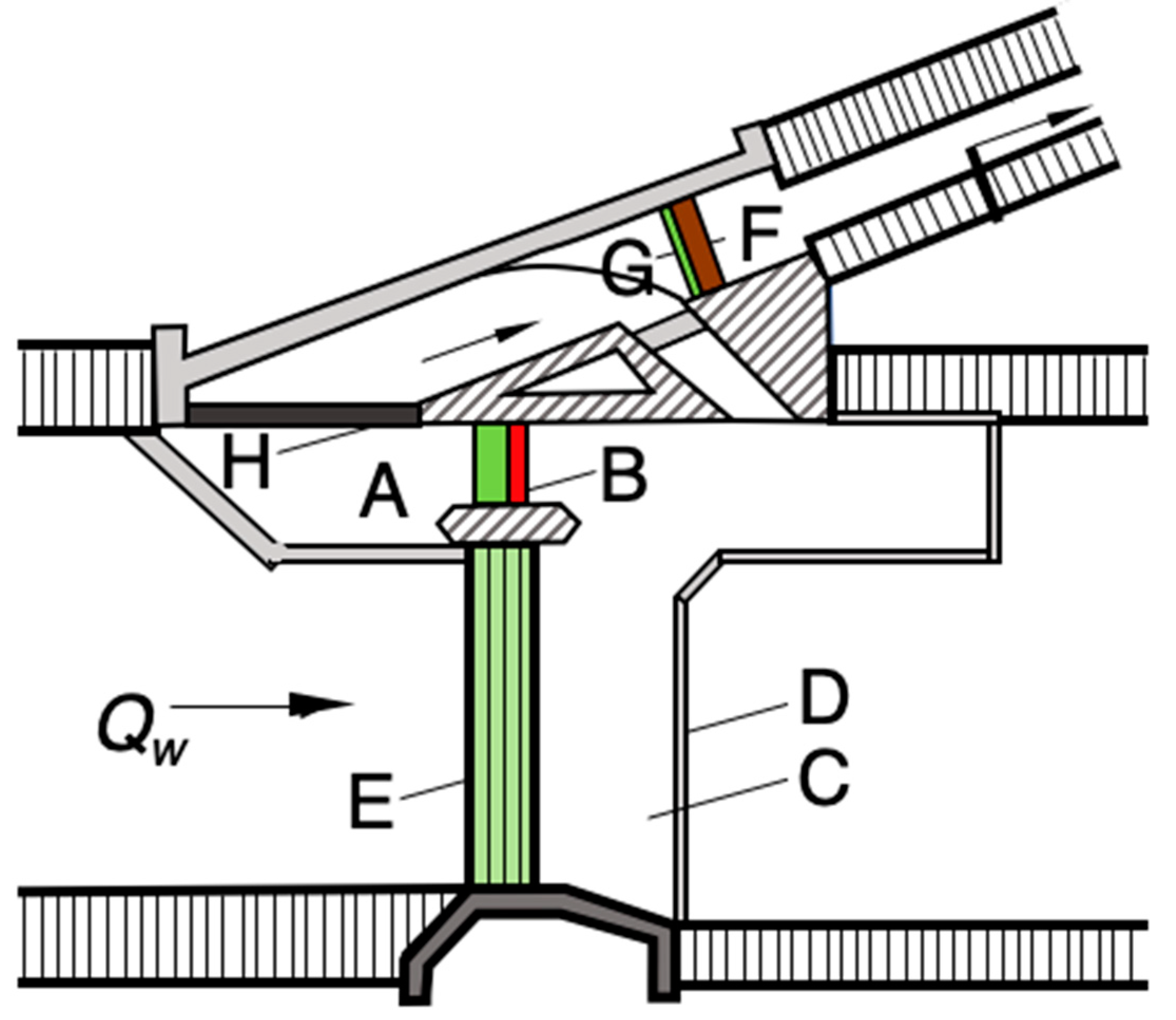

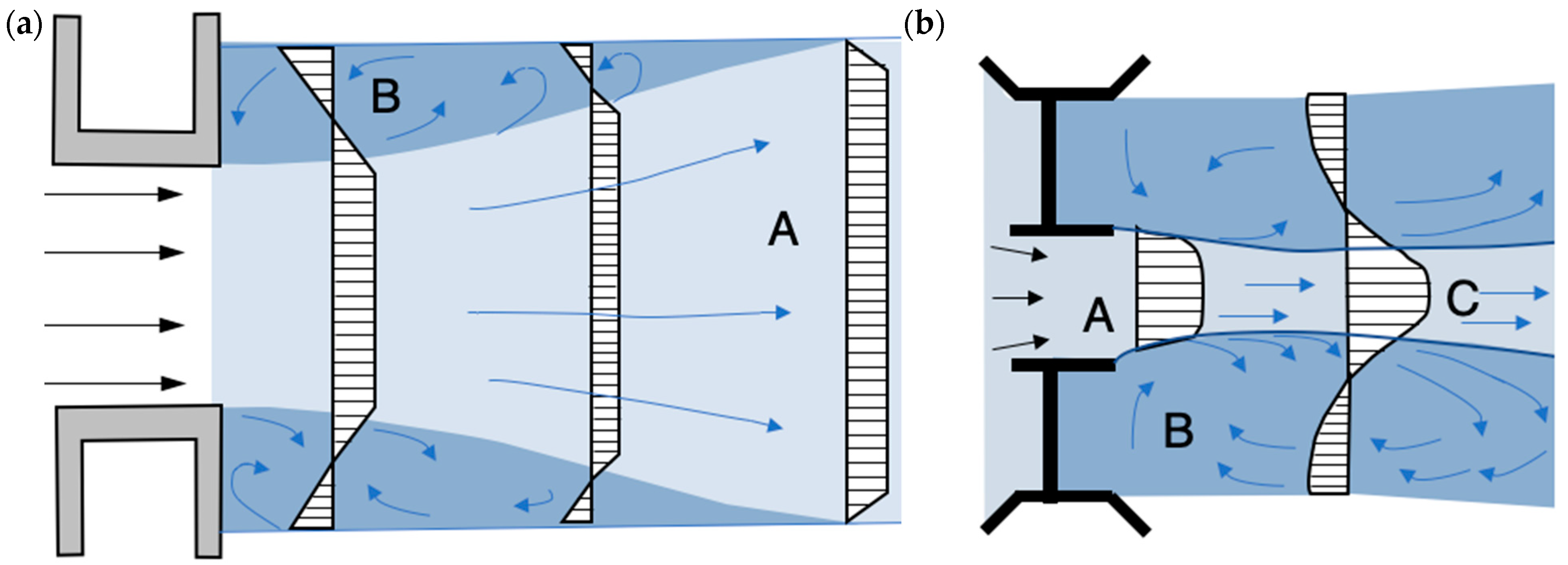

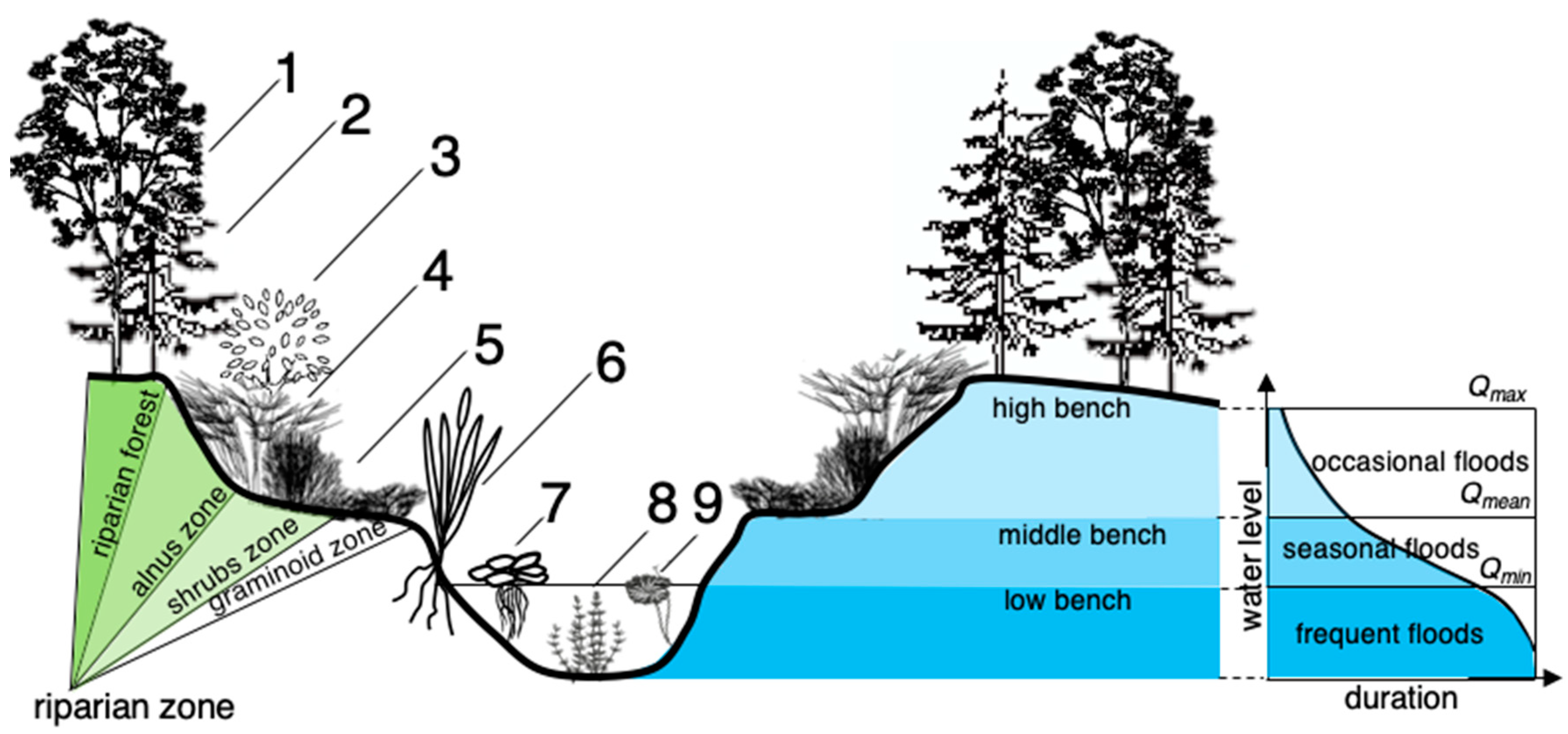
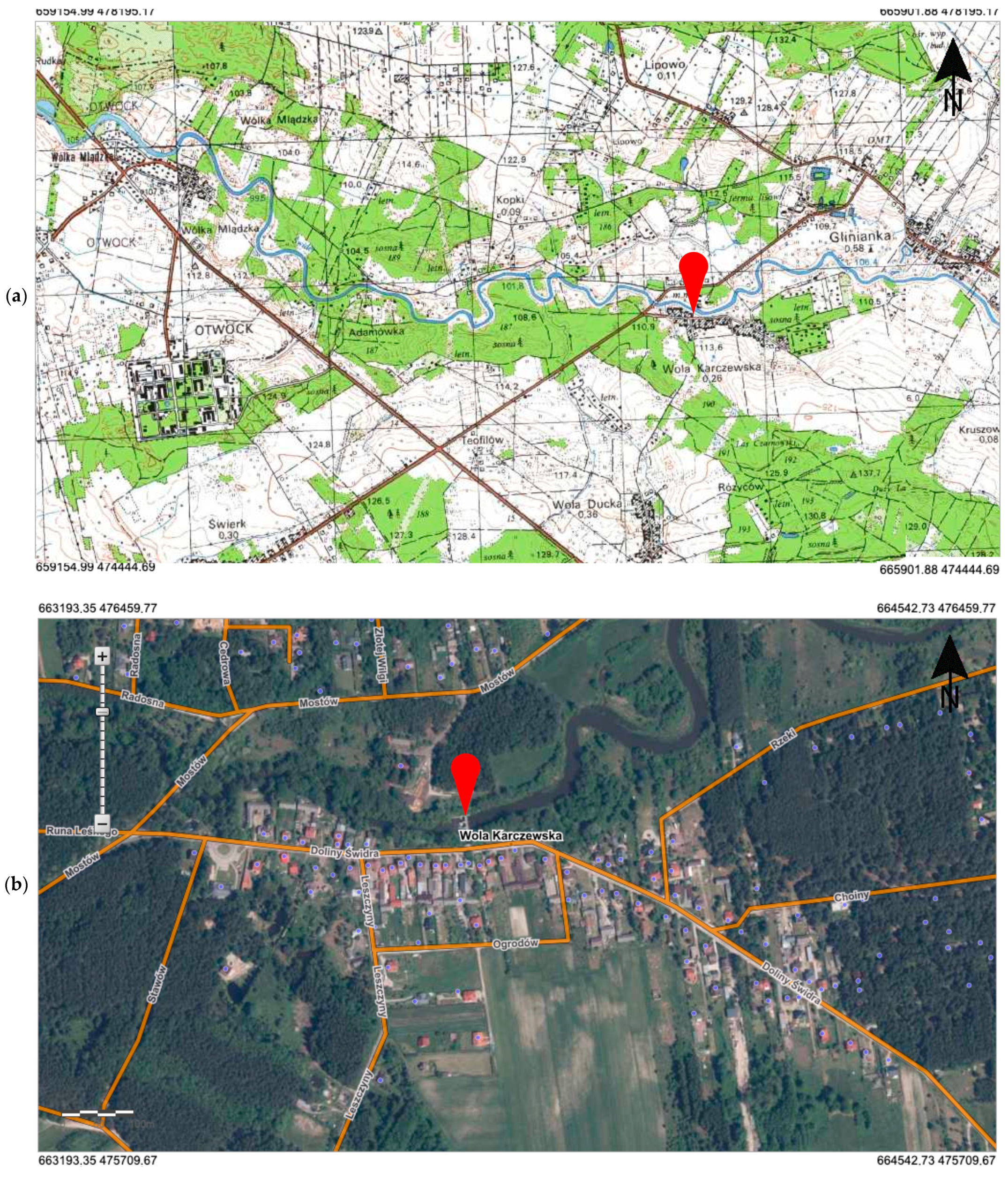



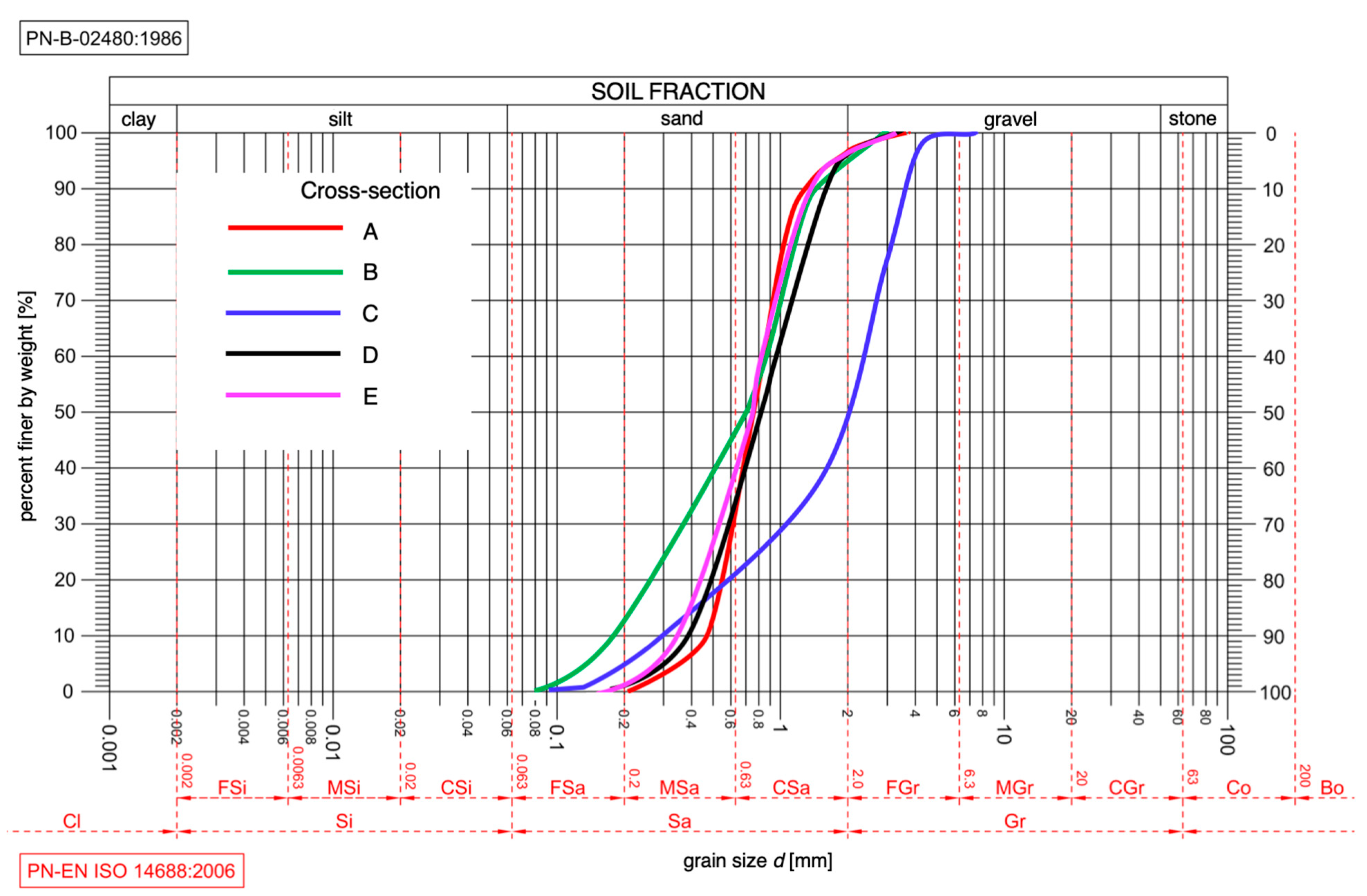

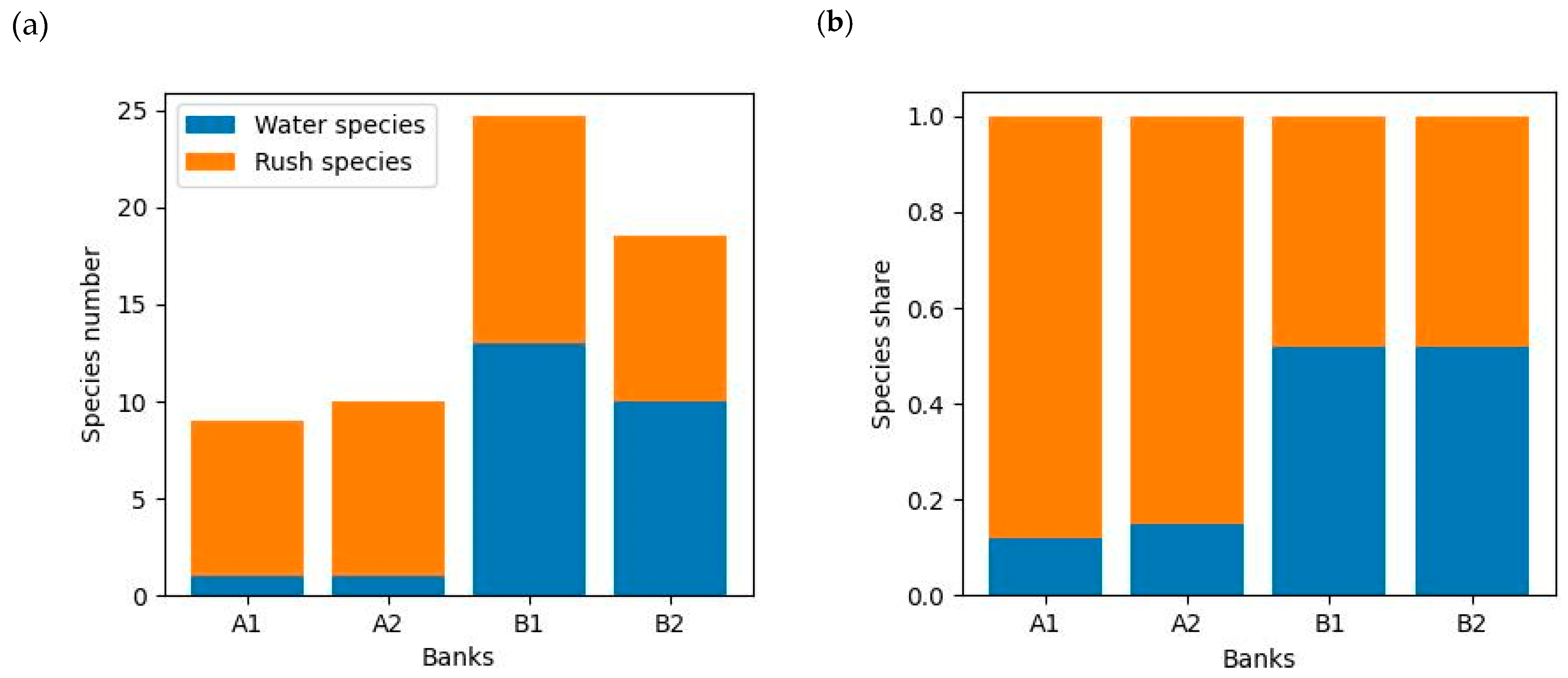
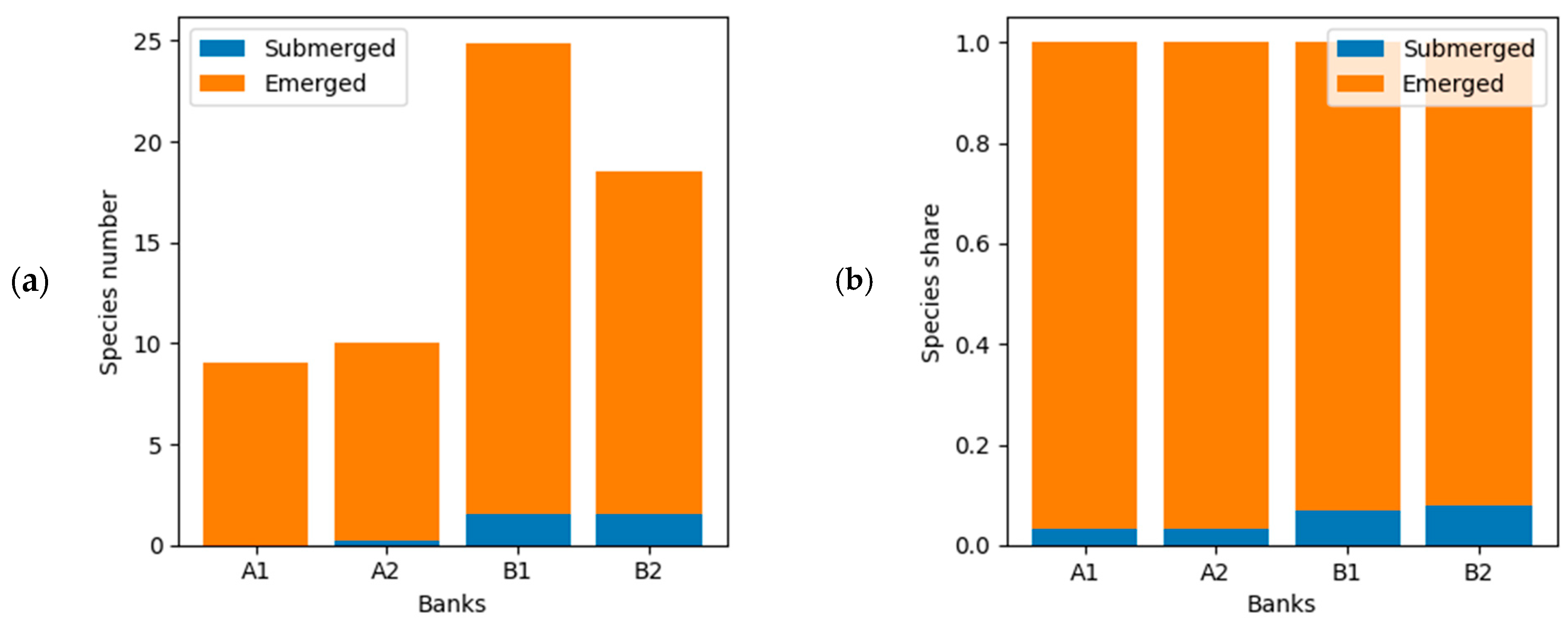
| Cross-Section | d10 | d50 | d60 | d90 | Cu | Granulation Uniformity | d50/d10 | d90/d50 | Fraction Predominance |
|---|---|---|---|---|---|---|---|---|---|
| [m] | [m] | [m] | [m] | [-] | [-] | [-] | [-] | ||
| A | 0.0005 | 0.0007 | 0.0008 | 0.0011 | 1.70 | U * | 1.53 | 1.53 | none |
| B | 0.0002 | 0.0007 | 0.0010 | 0.0012 | 5.28 | N * | 3.89 | 1.71 | d < d50 (MS **) |
| C | 0.0003 | 0.0020 | 0.0022 | 0.0035 | 7.33 | N | 6.67 | 1.75 | d < d50 (S **) |
| D | 0.0004 | 0.0008 | 0.0009 | 0.0013 | 2.30 | U | 2.05 | 1.59 | d < d50 |
| E | 0.0003 | 0.0006 | 0.0007 | 0.0012 | 2.19 | U | 1.94 | 1.94 | none |
| Species | Upstream | Downstream | p |
|---|---|---|---|
| Lemna minor | 0 | 34 | 5.5 × 10−9 |
| Lemnatrisculca | 0 | 33 | 9.2 × 10−9 |
| Hydrocharismorsus-ranae | 0 | 31 | 2.5 × 10−8 |
| Batrachiumcircinatum | 0 | 28 | 1.2 × 10−7 |
| Hottoniaplaustris | 0 | 27 | 2.0 × 10−7 |
| Eleocharis palustris | 0 | 25 | 5.7 × 10−7 |
| Nuphar luteum | 1 | 27 | 8.9 × 10−7 |
| Utricularia vulgaris | 0 | 24 | 9.6 × 10−7 |
| Alismaplantago-aquatica | 1 | 24 | 4.2 × 10−6 |
| Callitriche verna | 0 | 19 | 1.3 × 10−5 |
| Spirodelapolyrhiza | 0 | 19 | 1.3 × 10−5 |
| Ceratophyllumdemersum | 3 | 26 | 1.9 × 10−5 |
| Stratoidesaloides | 0 | 18 | 2.2 × 10−5 |
| Potamogetonnatans | 3 | 24 | 5.3 × 10−5 |
| Numphaea alba | 1 | 19 | 5.7 × 10−5 |
| Glyceria maxima | 4 | 26 | 5.9 × 10−5 |
| Myriophyllum spicatum | 0 | 12 | 5.3 × 10−4 |
| Potamogetonlucens | 6 | 24 | 1.0 × 10−3 |
| Nymphaea canadensis | 0 | 8 | 4.6 × 10−3 |
| Rumexhydrolapathum | 11 | 27 | 9.4 × 10−3 |
| Iris pseudoacorus | 5 | 17 | 0.011 |
| Siumlatifolium | 14 | 29 | 0.022 |
| Galiumpalustre | 18 | 33 | 0.035 |
| Carexacutiformis | 21 | 33 | 0.102 |
| Typha latifolia | 33 | 22 | 0.138 |
| Carexelata | 21 | 26 | 0.466 |
| Mentha aquatica | 32 | 28 | 0.605 |
| Phalarisarundinacae | 26 | 28 | 0.785 |
| Phragmites australis | 29 | 27 | 0.789 |
| Acorus calamus | 30 | 32 | 0.799 |
| Carexgracilis | 26 | 25 | 0.889 |
| Rorippaamphibia | 33 | 32 | 0.901 |
| Sagittariasagitiifolia | 29 | 29 | 1 |
Disclaimer/Publisher’s Note: The statements, opinions and data contained in all publications are solely those of the individual author(s) and contributor(s) and not of MDPI and/or the editor(s). MDPI and/or the editor(s) disclaim responsibility for any injury to people or property resulting from any ideas, methods, instructions or products referred to in the content. |
© 2023 by the authors. Licensee MDPI, Basel, Switzerland. This article is an open access article distributed under the terms and conditions of the Creative Commons Attribution (CC BY) license (https://creativecommons.org/licenses/by/4.0/).
Share and Cite
Kiraga, M.; Chyliński, F.; Fornal-Pieniak, B.; Ollik, M.; Staar, A. The Water Flow Regime in the Weir Area for Vascular and Rush Plant Species Composition. Water 2023, 15, 3189. https://doi.org/10.3390/w15183189
Kiraga M, Chyliński F, Fornal-Pieniak B, Ollik M, Staar A. The Water Flow Regime in the Weir Area for Vascular and Rush Plant Species Composition. Water. 2023; 15(18):3189. https://doi.org/10.3390/w15183189
Chicago/Turabian StyleKiraga, Marta, Filip Chyliński, Beata Fornal-Pieniak, Marcin Ollik, and Aleksander Staar. 2023. "The Water Flow Regime in the Weir Area for Vascular and Rush Plant Species Composition" Water 15, no. 18: 3189. https://doi.org/10.3390/w15183189
APA StyleKiraga, M., Chyliński, F., Fornal-Pieniak, B., Ollik, M., & Staar, A. (2023). The Water Flow Regime in the Weir Area for Vascular and Rush Plant Species Composition. Water, 15(18), 3189. https://doi.org/10.3390/w15183189









